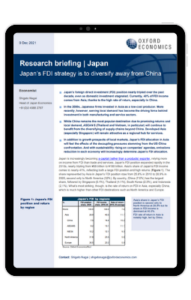Research Briefing
| Dec 10, 2021
Japan’s FDI strategy is to diversify away from China

Japan’s foreign direct investment (FDI) position nearly tripled over the past decade, even as domestic investment stagnated. Currently, 40% of FDI income comes from Asia, thanks to the high rate of return, especially in China.
What you will learn:
- In the 2000s, Japanese firms invested in Asia as a low-cost producer. More recently, however, serving local demand has become the driving force behind investment in both manufacturing and service sectors.
- While China remains the most popular destination due to promising returns and local demand, ASEAN 5 (Thailand and Vietnam, in particular) will continue to benefit from the diversifying of supply chains beyond China. Developed Asia (especially Singapore) will remain attractive as a regional hub for services.
- In addition to growth prospects of local markets, Japan’s FDI allocation in Asia will feel the effects of the decoupling pressures stemming from the US-China confrontation. And with sustainability rising on companies’ agendas, emissions reduction in each economy will increasingly determine Japan’s FDI allocation.
Tags:
Related Services

Post
Indonesia rate cuts will bolster credit demand, with pockets of risks
We forecast Bank Indonesia will start cutting its policy rate in Q2, which will provide a cyclical tailwind for credit growth and consequently domestic demand, as lower real lending rates will help boost loan demand.
Find Out More
Post
Commodities: Strong advanced economy demand boosts prices
Download our latest report on the price forecasts for oil, natural gas, iron, steel, base metals, precious metals, battery metals and food.
Find Out More